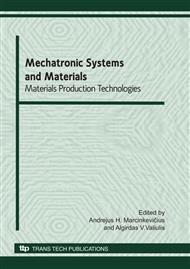p.50
p.56
p.61
p.66
p.73
p.79
p.85
p.91
p.97
Effects of Vibration Energy Input on Stress Concentration in Weld and Heat-Affected Zone of S355J2 Steel
Abstract:
The existence of residual stresses induced by the welding process is an important reason of cracking and distortion in welded metal structures that may affect the fatigue life and dimensional stability significantly [1]. Heat treatment is one of the traditional methods to relieve the residual stresses. But it is often limited by the manufacturing condition and the size of the structures. In this paper a procedure called vibratory stress relief (VSR) is discussed. VSR is the process to reduce and re-distribute the internal residual stresses of welded structures by means of weldment mechanical vibration during welding. Parameters of VSR procedure are described in the paper. Residual stresses on weld bead are measured in three different specimens by X-ray diffraction method. Mechanical tests of welded specimens were also performed with purpose to evaluate VSR effect in weld metal and heat affected zone (HAZ).
Info:
Periodical:
Pages:
73-78
Citation:
Online since:
June 2010
Price:
Сopyright:
© 2010 Trans Tech Publications Ltd. All Rights Reserved
Share:
Citation:


